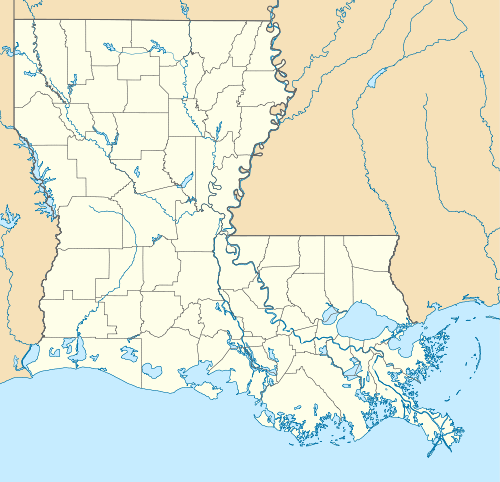Beauregard Parish Jail
|
Beauregard Parish Jail | |
 | |
 | |
| Location | Courthouse Square DeRidder, Louisiana |
|---|---|
| Coordinates | 30°50′46″N 93°17′20″W / 30.84611°N 93.28889°WCoordinates: 30°50′46″N 93°17′20″W / 30.84611°N 93.28889°W |
| Area | 0.2 acres (0.081 ha) |
| Built | 1914 |
| Architect | Steven-Nelson |
| Architectural style | Collegiate Gothic |
| NRHP Reference # | 81000711[1] |
| Added to NRHP | December 17, 1981 |
Beauregard Parish Jail is a former jailhouse in DeRidder, Louisiana built in 1914 in the Gothic Revival architecture style. It is referred to as the Gothic jail or the Hanging jail.[2] It was listed on the National Register of Historic Places[1] on December 17, 1981.[3] The jail is owned by the Beauregard Parish Police Jury. The Beauregard Parish Rehabilitation Committee serves under the direction of the Police Jury with the primary duty of the preserving the jail. The Beauregard Tourist Commission has a vested interest in the jail and other historic sites and has been involved in many aspects of securing a continued future of the jail.
History
The Hudson River Lumber Company donated a tract of land to the City of DeRidder for a courthouse and jail. The newly formed Beauregard Parish Police Jury, carved out of the old Imperial Calcasieu Parish,[4] purchased the property and a building from the church. Stevens-Nelson of New Orleans designed a courthouse and jail. Falls City Construction Company was awarded the contract in September 1913. Both buildings were completed in 1915 at a cost of $168,000.
Notoriety
"J. J. Brevelle was a taxi driver who was murdered by his "fares" while taking them to a rural destination. Brevelle is buried in Woodlawn Cemetery. The two men who were found guilty of his murder were hanged in the old parish jail on March 9, 1928. Deputy Sheriff Gill was the hangman. Joe Genna, age 25, was pronounced dead at 1:06 PM and Molton Brasseaux at 1:29 PM. Neither man was buried in Beauregard Parish." [5][6]
It was after this incident, the Beauregard Parish Jail, sometimes referred to as the Gothic jail, also became known as the Hanging Jail
Culture
The structure not only made history because of its unique design but also because there was a toilet, shower, lavatory and window in each cell. A large spiral staircase gave access to each cell. Architectural historian Johnathan Fricker stated, "The old jail is unique in structure, it has the possible distinction of being the only penal institution in the country using "Collegiate Gothic" design in the first decade of the 20th century."[7] The jail could "house" over 50 prisoners. There was a jailers' quarters on the bottom floor as well as a kitchen. There is a tunnel leading from the courthouse to the jail that was used to transport prisoners for trial.
Current
The building is currently not in use. Options are being explored as to current plans for the jail. On 2 August 2007, the Beauregard Tourist Commission submitted the building (noted as Beauregard Parish Jail "Gothic Jail") for inclusion in the Louisiana Preservation Alliance's annual Ten Most Endangered List.[8] This will open new avenues for funding for the building. Negotiations are underway for the jail to be used in an up-coming movie.[9]
References
- 1 2 Staff (2010-07-09). "National Register Information System". National Register of Historic Places. National Park Service.
- ↑ , -Hanging Jail
- ↑ Beauregard Parish. National register list.
- ↑ Founded January 1, 1913
- ↑ Beauregard Parish History At The Millennium-retrieved December 25, 2009
- ↑ Copyright information listed in the book; "This material was compiled for public use, not for profit. The sole purpose was to provide the public with an easy to read version of local history".
- ↑ Quote: DeRidder Louisiana; The first 100 years 1903-2003, page 386 -Retrieved December 26, 2009
- ↑ Letter from the Beauregard Tourist Commission to the Louisiana Preservation Alliance. On file in their office.
- ↑ -Possible filming at lail
Further reading
- DeRidder Louisiana; The first 100 years, 1903–2003
External links
| ||||||||||||||||||||||||||